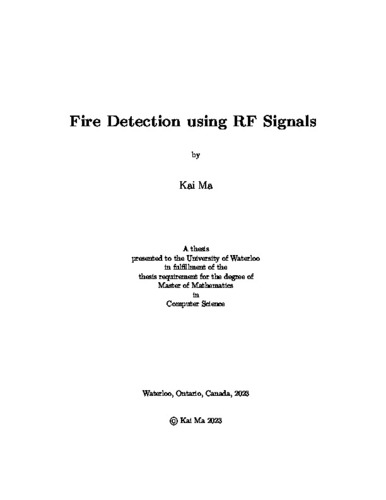UWSpace will be migrating to a new version of its software from July 29th to August 1st. UWSpace will be offline for all UW community members during this time.
Fire Detection using RF Signals
| dc.contributor.author | Ma, Kai | |
| dc.date.accessioned | 2023-09-20 15:41:07 (GMT) | |
| dc.date.available | 2024-01-19 05:50:07 (GMT) | |
| dc.date.issued | 2023-09-20 | |
| dc.date.submitted | 2023-09-12 | |
| dc.identifier.uri | http://hdl.handle.net/10012/19896 | |
| dc.description.abstract | Structural fires can be a major threat to life and property. Contemporary smoke alarms suffer from drawbacks such as long response times, lack of penetration through walls, and nuisance (false-positive) alarms. In this thesis, we examine the feasibility of using RF signals for fire detection. We focus on RF signals in the 5 GHz frequency band in the first part of the thesis, which corresponds to the same frequencies that have been used in previous research on Wi-Fi fire detection. We then move on to the 28 GHz frequency band since there is some existing work on fire detection using millimeter wave (mmWave) signals at 77 GHz. We would like to adapt the technique to 28 GHz mmWave 5G signals because, in theory, 28 GHz signals would have better propagation properties than 77 GHz signals and could provide better range and coverage. For RF signals at 5 GHz, a Virtual Network Analyzer (VNA) is used to study the impact of fire on the signals. The signal strength and phase are recorded in each round of the experiments. We observe only moderate changes in the signal strength and phase from heptane fire when the distance between the two antennas of the VNA is small (1.3 meters). However, the impact of heptane fire becomes imperceptible when we conduct the same experiment with a longer distance between the two antennas (3 meters). We also study the impact of wood fire and smoke at a distance of 3 meters. The fire itself does not have any noticeable impact on the signal strength or phase, but the dense smoke generated after the fire is extinguished results in significant changes in both signal strength and phase. After comparing the magnitude of changes in the signals from the VNA with the fidelity of commodity Wi-Fi devices, we think it is unlikely that the Wi-Fi devices used in previous work could be used to detect fire at a distance that would be practical in real deployments. In a previous study by Zhong et al., the authors only show data from 1 second before to 1 second after the fire starts. We believe that the changes in signals they observe may be caused by the movement of the person who lights the fire. We also conduct some simple experiments to help support this theory. We examine the feasibility of using mmWave RF signals for fire detection by starting a fire between a 5G base station and a mobile device, both of which operate in the 28 GHz (mmWave) band. We consider several metrics available on the mobile device, including RSRP PRX, RSRP DRX and RSSI. We then conduct experiments using 3 different distances between the base station and the mobile device (3, 28, and 60 meters). Unfortunately, we are unable to observe any patterns in RF signal changes that correspond to the time when the fire is burning in any of the 3 scenarios. Additionally, the RSSI value does not change in any of our experiments due to how it is reported on the mobile device. We conclude that the 5G device used in our experiments may not be suitable for fire detection. | en |
| dc.language.iso | en | en |
| dc.publisher | University of Waterloo | en |
| dc.subject | fire detection | en |
| dc.subject | RF signal | en |
| dc.subject | Wi-Fi | en |
| dc.subject | 5G | en |
| dc.title | Fire Detection using RF Signals | en |
| dc.type | Master Thesis | en |
| dc.pending | false | |
| uws-etd.degree.department | David R. Cheriton School of Computer Science | en |
| uws-etd.degree.discipline | Computer Science | en |
| uws-etd.degree.grantor | University of Waterloo | en |
| uws-etd.degree | Master of Mathematics | en |
| uws-etd.embargo.terms | 4 months | en |
| uws.contributor.advisor | Brecht, Tim | |
| uws.contributor.affiliation1 | Faculty of Mathematics | en |
| uws.published.city | Waterloo | en |
| uws.published.country | Canada | en |
| uws.published.province | Ontario | en |
| uws.typeOfResource | Text | en |
| uws.peerReviewStatus | Unreviewed | en |
| uws.scholarLevel | Graduate | en |

